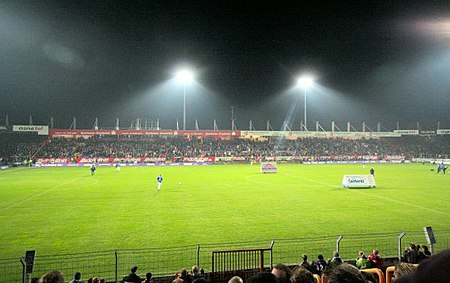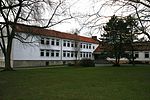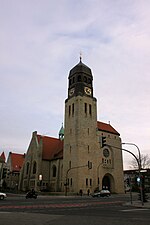Stadion an der Bremer Brücke

Stadion an der Bremer Brücke or Bremer Brücke is a football stadium in the Schinkel district of Osnabrück, Germany. It is used mostly for football matches and is the home stadium of VfL Osnabrück. The stadium currently holds 16,100 people and was opened in 1933. From the 1970s, the stadium consisted of the Grandstand ("South Stand"), two roofed terraces behind the goals ("East Stand" and "West Stand"), and an uncovered terrace opposing the grandstand ("North Stand"). On 1 April 2008, demolishing works of the very old North Stand started to make way for a modern entirely roofed stand to be built at the site. The new stand was opened in August 2008; however, there has been controversy with a local resident whose property is situated very close to the ground. For this reason, the stand could not be fully completed earlier than 2011. With the construction of the new stand, the overall stadium capacity decreased to 16,667, but seating capacity rose to 6,192. The name, which can be translated as "Stadium at Bremen Bridge", comes from a neighbouring railway bridge of the Osnabrück–Bremen railway line. In 2004, a local telecommunications company, Osnatel, bought the naming rights for the stadium and it was renamed to "Osnatel Arena". When the contract expired in 2016, the stadium got back its traditional name.
Excerpt from the Wikipedia article Stadion an der Bremer Brücke (License: CC BY-SA 3.0, Authors, Images).Stadion an der Bremer Brücke
Hannes-Haferkamp-Platz, Osnabrück Schinkel
Geographical coordinates (GPS) Address Website External links Nearby Places Show on map
Geographical coordinates (GPS)
| Latitude | Longitude |
|---|---|
| N 52.280833333333 ° | E 8.0711111111111 ° |
Address
Stadion an der Bremer Brücke
Hannes-Haferkamp-Platz 1
49084 Osnabrück, Schinkel
Lower Saxony, Germany
Open on Google Maps








